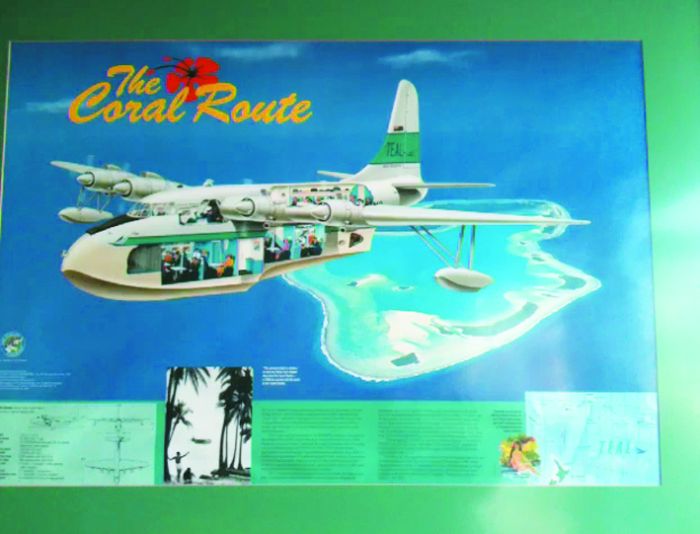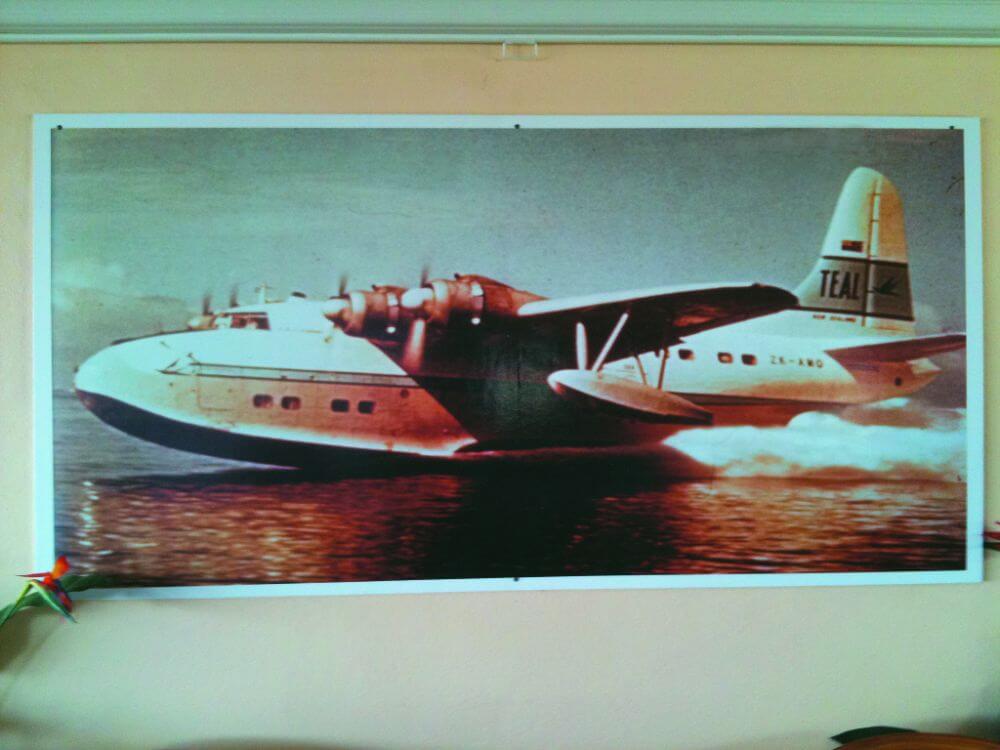Author : Peter Layne
Mention The Coral Route flying boat service to those who remember it and their minds will flash back to those large white Short Solent flying-boat aircraft of TEAL (Tasman Empire Airways Limited), the forerunner of Air New Zealand. How many of them will realise though that it is over 50 years ago since the flying-boat service ended?
When the first flight took place in December 1951, aboard Solent ZK-AMQ Aparima, it stretched between Auckland, Suva, Aitutaki and Tahiti. Apia was added to the service in October 1952.
Before TEAL could complete its island hopping route it was necessary to survey the lagoons to find the safest landing areas and this was achieved with a Catalina flying boat, ZK-AMP, lent to TEAL by the RNZAF in May 1951. The crew consisted of Cliff Le Couteur, (Captain) Mauri McGreal, (Co-pilot) Bert Carlyon, (Engineer) “Jacko” Jackson (Radio Operator) and Ron Oliver (Engineer). The survey began in June 1951 and concluded in August 1951. The survey’s official name was Pacific Sea Alighting Areas (PACSAA). Explosives were used, particularly in the Satapuala Lagoon in Samoa, to remove any coral tops that were so close to the surface that could have snagged the aircraft, which could have had disastrous results.
At the outset the service did not have a name so TEAL held a competition after the first round trip was completed. It was won by Eric Mullane who had been the steward on that first flight and he suggested “Coral Route”, which was a clear winner. Passengers could board the lavishly appointed two-deck Solents in Auckland and “cruise” in luxurious style with plenty of legroom. Silver service meals were prepared on board by a chef in a spacious galley. There was entertainment at every stop, not to mention the actual holiday at the destination! What a way to travel! Such travel was not cheap though and there was no choice of class – it was first class only!

New Zealand National Airways Corporation (NAC) had been operating a fortnightly “regional” service from Auckland since November 1947 via Norfolk Island, Fiji, Tonga and Samoa and both Aitutaki and Rarotonga (where the service terminated). The NAC service was curtailed once the Coral Route came into operation. Of particular significance was the fact that Rarotonga was not included on the Coral route and that Aitutaki was primarily a refuelling stop only.
In June 1954, the Solents were replaced by Douglas DC-6 aircraft on most of TEAL’s routes, including the Auckland to Fiji sector, which became known as the Hibiscus Route. Three of the five Solents were then permanently withdrawn from service. Because the DC-6s were land-based aircraft and Suva’s Nausori Airport was of insufficient length, the DC-6s operated to Nadi making it necessary for ongoing passengers to be transferred to Suva to join the Coral Route. They would normally arrive in Suva by late afternoon where they would spend the night dining and being entertained in the Grand Pacific Hotel. Next morning the flight to Samoa would start from the nearby Royal New Zealand Air Force (RNZAF) maritime base at Laucala Bay, aboard the Solent.

On arrival in Samoa they were met by a line-up of young Samoan maidens with leis and floral headbands in the Polynesian way. Later, at the renowned Aggie Grey Hotel they would spend the evening in Samoan fale, dining and being entertained. At midnight they would set out to the departure terminal and take off for the next leg of the journey to Tahiti with a refuelling stop at dawn on Aitutaki’s lagoon.
While the passengers disembarked and had a tropical breakfast, a fuelling barge would be busy pumping fuel into the aircraft tanks. Young local women were employed as ground hostesses to welcome the passengers during their short stay. There were occasions when the weather dictated an overnight stop at Aitutaki. Since the purpose for most of the passengers was to have a holiday, there were few complaints if the weather prevented the flight leaving Aitutaki on time. What better excuse could there be for another night of entertainment at an unscheduled exotic stopover! It also provided very welcome tourist money for the local economy.

There was one occasion when a Solent had engine problems at Aitutaki, leaving Captain “Joe” Shephard with no option but to leave the passengers and cabin crew (steward and two hostesses) behind with the food while the aircrew carried on to Tahiti to get the engine repaired. Apparently it took eight days to get the repaired aircraft back to Aitutaki.
After having the holiday at their chosen destination in the Pacific, passengers would re-board the faithful Solent for the westbound journey back to Suva, complete with intervening stopovers.
Modern times were catching up with TEAL and by 1957 the Solent fleet had dwindled to one aircraft with the withdrawal of ZK-AMQ Aparima, which was broken up in Auckland. Popular as they were, the Solents were becoming uneconomic to operate and so the remaining Solent, ZK-AMO Aranui, normally flown by Captain Shephard, faithfully served the Islands for three more years. On that sad day, 1 September 1960, Aranui set off on its last Coral Route service to Tahiti and returned to Suva for the last time on 6 September ending nine years of reliable service.

The withdrawal of the Solent meant that TEAL would not maintain its presence in the Cook Islands with the DC-6s and newer Lockheed Electra aircraft. The runway at Rarotonga was not long enough to cater for these larger aircraft. Instead, the Electras, which had replaced the DC-6s, overflew the Cook Islands and flew on to Tahiti. A Douglas DC-3 aircraft of Polynesian Airlines maintained a service, which included the Cook Islands, from 1963, for a few years. RNZAF aircraft became the most regular callers at Rarotonga It was not until the runway was extended and officially opened by Her Majesty Queen Elizabeth II in January 1974 that TEAL (by then renamed Air New Zealand) resumed services, using Douglas DC-8 jet aircraft. In subsequent years, other Air New Zealand aircraft have plied the route direct from Auckland and include Douglas DC-10, Boeing 737, 747, 767, 777 and Airbus A320 types. These days, Air Rarotonga operates regular services from Rarotonga to the former US Air Force base at Aitutaki, ensuring regular services are maintained for tourists and for the Islands’ infrastructure.

What happened to the last Solent? After returning to Auckland, just after 4pm on 14 September 1960, the Solent languished on the hard standing area at the RNZAF base Hobsonville, Auckland, where it shared company with the remaining Short Sunderland flying-boats. But that was not to be the end of Solent Aranui. There was a strong possibility she would be broken up for scrap but fortunately the newly formed Museum of Transport and Technology (MOTAT) in Auckland had their eye on her. The Museum at that stage did not have suitable land to accommodate the Solent and so she sat on the Air Force base until the Museum’s site at the Keith Park Memorial Airfield in Meola Road, Point Chevalier became available. On 7 May 1966, she was towed across the harbour in readiness for the final move next day. Early on 8 May 1966, Aranui was “beached” for the last time and hauled across Meola Road to her new home. Waiting to welcome her was her old friend Captain Shephard. For many years Aranui sat in the open in company with Sunderland flying boat, NZ4115, which went to MOTAT in 1967.

Finally, a hangar was built to house her and once under cover the major job of restoring her took place, largely done by former TEAL staff on a voluntary basis. The work by these loyal volunteers, men and women, is testimony to their dedication for what that Solent meant to them. The workmanship in bringing her back to pristine condition has to be seen to be believed. Though never expected to fly again, Solent ZK-AMO, the only Mark IV Solent remaining world-wide, stands as a memorial to all Solents and to the Coral Route. In 2010 there was a surprise in store. Once more, Aranui ventured outside where she sits at the time of writing this article. The hangar is being extended to house the remaining aircraft which have sat outside for many years, including the Sunderland which has been outside ever since arriving at MOTAT. Before going back inside there is the possibility Aranui may get a fresh coat of paint.





